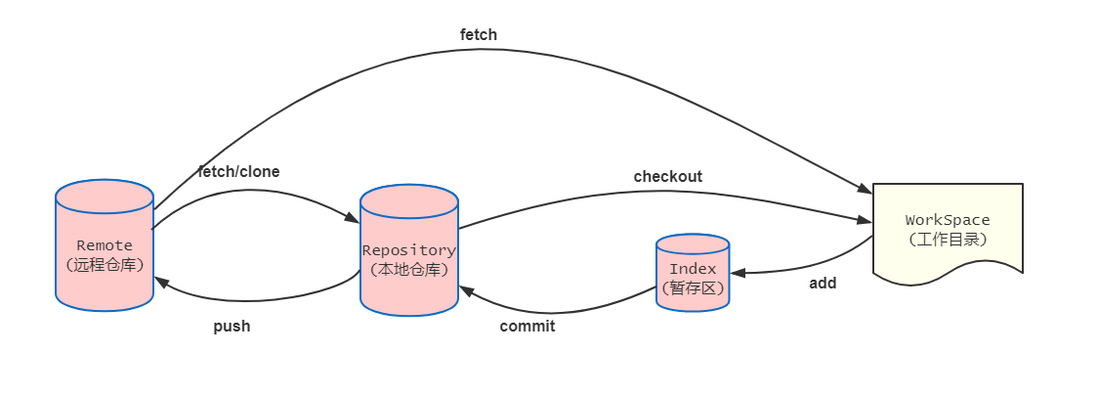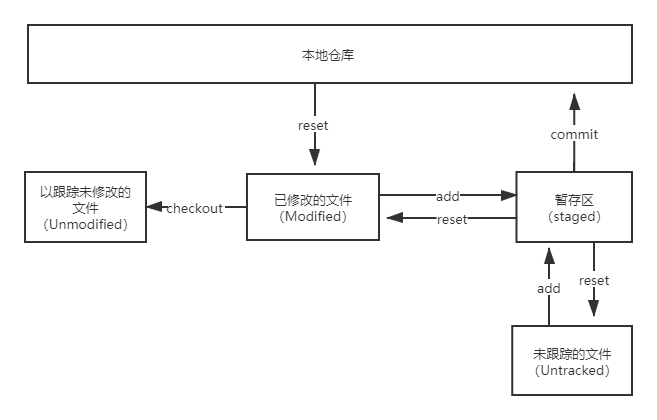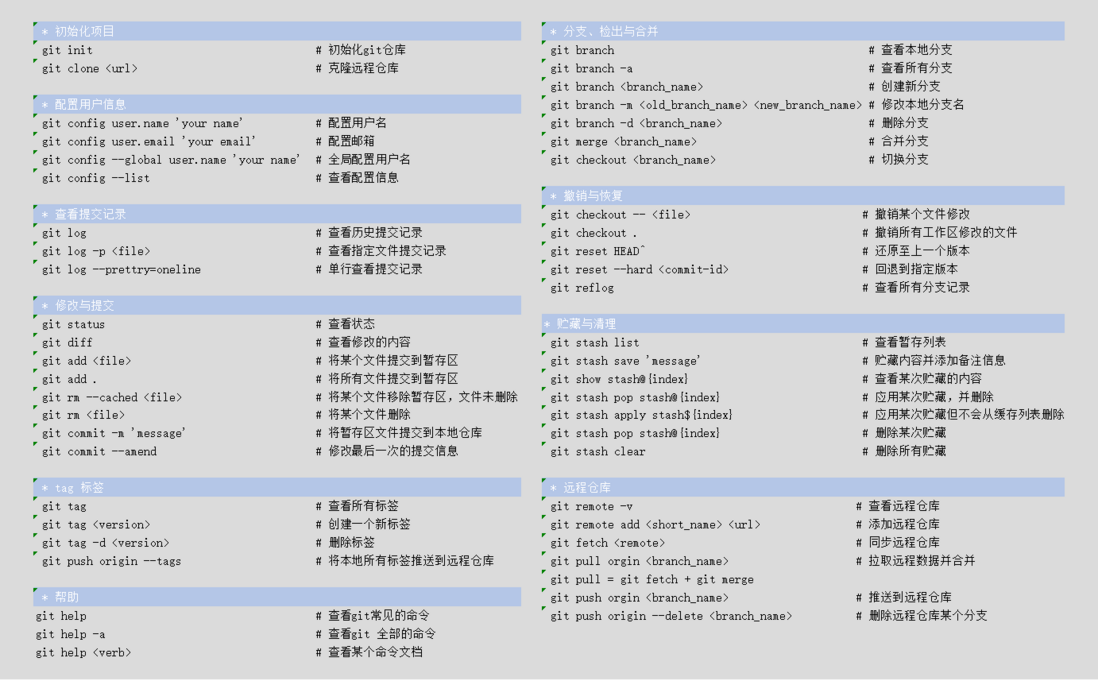

一学就会的git命令
source link: https://segmentfault.com/a/1190000038752672
Go to the source link to view the article. You can view the picture content, updated content and better typesetting reading experience. If the link is broken, please click the button below to view the snapshot at that time.
一学就会的git命令
一学就会的git 命令
使用git 已不知好几年,最近想着把常用的一些git 命令做个总结,本文主要写的是git常用的命令。
阅读三连:点赞(👍)、关注(😍)、收藏(📝)。
本文 github (一学就会的Git命令操作) 已上传,更多往期文章已分类整理。
几个常用的命令
mkdir folder_name // 创建文件夹 [folder_name: 文件夹名称,举个栗子:git-demo]
cd folder_name // 进入文件夹
touch file_name // 创建一个文件 [file_name:文件名称,举个栗子:index.js]
vim file_name // 编辑一个文件 [举个栗子:vim index.js]
rm -rf file_name // 删除文件或者文件夹 [rm -rf file_name]
ls // 显示工作目录
clear // 清除屏幕获取git 仓库
1.第一种方式,将本地项目转换成git 仓库, 生成一个.git文件;
mkdir git-demo //创建一个文件
cd git-demo
git init // 创建一个名为 .git 的子目录2.第二种方式,拉取(克隆)远程已存在的git仓库;
git clone <url> // url 仓库地址
git clone https://github.com/FishStudy520/git-demo.gitgit config (配置用户信息)
配置用户信息(用户名和邮箱);
git config user.name 'your name' // 配置用户名
git config user.email 'your email' //配置用户邮箱查看配置信息 (显示配置信息);
git config --list 全局配置用户只需要加 --global;
git config --global user.name 'your name' // 全局配置用户名git help (查看文档)
查看常见的命令;
git help 查看git全部的命令;
git help -a 查看git命令某个文档, 举个栗子:
git help add git status (查看状态)
git status 主要用于查看工作区与保存区的状态;文件状态如以下三种:
Untracked files: 未跟踪的文件,新创建的文件 (未跟踪的文件);
Changes to be committed:保存已修改的文件,该文件运行在git add 的版本历史记录中,但还没有commit ;
Changes not staged for commit: 保存已修改的文件;
- 未跟踪的文件(Untracked)和已修改的文件(Modified)通过
git add .提交到暂存区区,使用git reset HEAD <file>还原到git add .时的状态; - 已修改的文件(Modified)使用
git checkout .将以跟踪所有已修改的文件,还原到修改前的状态(Unmodifed); - 以跟踪未修改的文件(Unodified)通过本地仓库切换出新分支所得;
查看状态,简写参数:-s
git status -sgit add(添加到暂存区)
将文件/文件夹提交到暂存区,添加单个或者多个;
git add file file1 ...将当前目录下的所有文件添加到暂存区(包含修改的文件以及新增文件);
git add .将已经监控的文件添加到暂存区(不包含新增的文件);
git add -u将当前项目下的所有变化都添加到暂存区;
git add -Agit commit(提交本地仓库)
Git commit将工作区的内容提交到本地仓库,每次提交生成一个commit-id,在版本回退起了重要的位置。
将工作区内容提交到本地仓库;
git commit -m 'message'将暂存区已修改的文件提交到本地仓库,注:已版本控制的文件;
git commit -a -m 'messgae'如果我们最近一次的提交信息写错了,可以使用下面命令修改;
git commit --amendgit 分支
查看本地仓库下的分支,标记“*”的是当前工作区分支;
git branch 查看所有的分支(本地仓库以及远程仓库分支),-a 是 --all的简写;
git branch -a 创建一个新分支;
git branch <branch_name> //branch_name: 新分支名称切换分支,比如你现在在master分支上,切换到develop分支;
git checkout develop // 切换到develop分支删除某个分支,-d 是 --delete的简写;
git branch -d <branch_name> // branch_name:需要删除的分支名
// 举个栗子:删除develop 分支
git branch -d develop
// 强制删除某个分支,分支未合并,如果想删除,就使用下面命令;
git branch -D develop打印当前分支名称;
git branch --show-current显示与工作区分支已合并的分支;
git branch --merged显示与工作区分支未合并的分支;
git branch --no-mergedgit checkout (检出)
git checkout主要的作用是切换分支或者还原工作区文件的变更。
切换分支;
git checkout <branch_name> // branch_name:分支名称
git checkout develop //切换到develop 分支创建新分支并且切换到这个分支上;
git checkout -b <branch_name> // branch_name:新增分支名称
git checkout -b develop // 创建develop 分支并切换到develop分支上忽略工作区的修改,切换分支;
git checkout -f <branch_name> // 忽略修改切换到 branch_name 上git merge(合并)
git merge的作用就是将指定的分支合并到当前分支;
合并分支;
git merge <branch_name> // branch_name: 分支名称在合并分支时,产生合并冲突,退回到合并前的状态;
git merge --abortgit log(提交记录)
查看所有的提交记录;
git log // 按 字母 q 退出查看参数
--oneline: git log 的简写,输出7个commit hash 的前7个字符,以及提交说明;
git log --oneline -p:查看每次提交改变的差异,这个很详细;
git log -p // 查看每次提交改变的差异
git log -p <file> // 查看指定文件的提交记录--stat:查看每次提交的简略信息,可以快速查看每次提交的差异,比-p简洁;
git log --stat--prettry:这个参数用于自定义输出格式信息;比如:oneline[单行],format[定制时间格式]
git log --prettry=oneline -n: n代表限制输出的数量,最近的n条提交信息;
git log -2 // 最近两条的提交信息--graph:查看在日志旁以 ASCII 图形显示分支与合并历史;
git log --graphgit diff(查看差异)
查看当前工作区与保存区文件修改了哪些内容(不包含新文件);
git diff 查看当前工作区与上一个版本的差异;
git diff HEAD
git diff commit-id // 与commit-id版本比较差异,commit-id:对应提交的版本号查看当前工作区与另一个分支的差异;
git diff master // 与master 分支比较差异查看对比两个分支间的差异;
git diff master...develop // 对比master分支与develop 分支的差异查看哪些文件改动了,有多少,可以使用--stat参数;
git diff --statgit tag(打标签)
git tag用来标记git 版本的标记;
查看所有的tag 标记;
git tag 创建一个tag标记;
git tag v0.0.1 查看某个tag的详情内容;
git tag <tag_name> // tag_name: tag名称
// 比如:查看v0.0.1 标记
git tag v0.0.1删除某个tag;
git tag -d v0.0.1推送本地tag到远仓库;
git push origin --tags查看远程仓库的所有tag;
git ls-remote --tags origin以某个tag 创建新分支;
git checkout -b <branch_name> <tag_name> // branch_name:新分支名,tag_name: tag名git 远端仓库
查看远程仓库;
git remote -v添加远程仓库;
git remote add <short_name> <url> // short_name: 简短的名称,url:远程仓库地址
// 举个栗子:
git remote add fishStudy520 https://github.com/FishStudy520/git-demo.git从远程仓库拉取和抓取到本地仓库,但未合并(同步远程仓库数据);
git fetch <remote> //remote: 远程地址从远程仓库拉取和抓取到本地仓库,并且合并数据(同步远程仓库数据);
git pull origin master // 拉去远程仓库数据删除远程仓库的某个分支;
git push origin --delete <branch_name> // branch_name: 远端分支名推送到远程仓库;
git push origin master // 推送到远程仓库的master分支查看某个远程仓库;
git remote show origin修改远程仓库名称;
git remote rename old_name new_name
// 举个栗子:
git remote rename fishStudy520 fish001移除远程仓库;
git remote remove fishStudy520 //移除远程仓库 fishStudy520git pull 与 git fetch 的区别:
git pull = git fetch + git merge贮藏与清理
执行贮藏操作,是将修改暂时存储到堆栈中
场景:当你在项目上修改一些内容,而现在临时线上有个紧急bug 需要修复,但是你不想这么一会就创建一次提交,这时使用stash,将修改保存。等Bug 修改完后,再次切回原分支,从堆栈中恢复刚刚贮藏的内容。
贮藏内容,添加备注信息,方便以后查找;
git stash save <message> // message:备注信息(可选参数下)
or
git stash //不添加备注信息查看贮藏列表;
git stash list查看贮藏的内容变更,默认显示第一个,如果查看其他的贮藏,在stash${num},num代表哪个贮藏;
git show stash //默认第一个,索引为0,
git show stash@{1} // 查看第二次贮藏的内容有哪些应用某个贮藏,但不会在堆栈列表中删除,这里的索引从0开始;注:0最新的一次保存,1上一次贮藏,以此类推;
git stash apply // 默认使用最近一次的贮藏,相当于 git stash apply stash${0}
git stash apply stash${1} // 使用第二个贮藏应用某个贮藏,并且从堆栈列表中删除;
git stash pop stash@{2} // 使用第3个贮藏,并且删除从缓存中删除将之前的某次贮藏从列表中删除;
git stash drop stash@{2} // 丢弃列表中的第3次贮藏删除所有贮藏的stash;
git stash clear如果喜欢或对你有用,那就点个赞呗(👍👍👍)! (╯ε╰)(╯ε╰)(╯ε╰)。
Recommend
About Joyk
Aggregate valuable and interesting links.
Joyk means Joy of geeK


